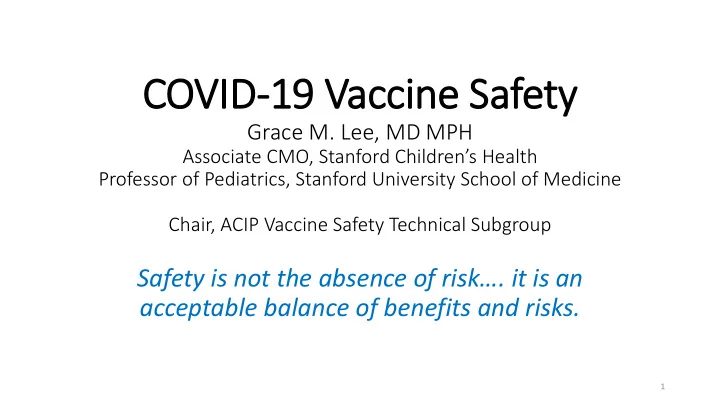

COV OVID-19 19 Vacci cine S Safety Grace M. Lee, MD MPH Associate CMO, Stanford Children’s Health Professor of Pediatrics, Stanford University School of Medicine Chair, ACIP Vaccine Safety Technical Subgroup Safety is not the absence of risk…. it is an acceptable balance of benefits and risks. 1
2 Independent Advisory Committees Review Safety To provide advice to the Commissioner of FDA • Vaccines and Related To evaluate data concerning safety , effectiveness and • Biological Products Advisory appropriate use of vaccines…for which the FDA has Committee (VRBPAC) regulatory responsibility. To provide advice and guidance to the Director of the CDC • To provide recommendations on use of vaccines in the U.S. • Advisory Committee on civilian population based on disease epidemiology, vaccine Immunization Practices safety , vaccine efficacy and effectiveness, quality of evidence reviewed, economic analyses, and implementation issues. 2
ACIP - Vaccine Safety • Vaccine safety data is routinely considered by ACIP workgroups and full ACIP deliberations about benefit-risk balance and recommendations for use • ACIP is routinely updated on post-market safety and effectiveness data for vaccines, and modifies recommendations, if needed. • For COVID-19 vaccines, a separate safety group was assembled in Jun 2020 to support the COVID-19 Vaccine Workgroup and the full ACIP on the safety of COVID-19 vaccines in development and post-approval. 3
COVID-19 Vaccine Safety Technical (VaST) Subgroup • ACIP members • CDC Lead • Grace Lee • Tom Shimabukuro • Beth Bell • Ex Officio Members • Keipp Talbot • CDC • Consultants • FDA • Ed Belongia • DoD • Matthew Daley • VA • Kathy Edwards • IHS • Martin Kulldorff • HRSA • Laura Riley Stanley Perlman • HHS • Vish Viswanath • NIH • BARDA 4
VaST - Terms of Reference - As of May 2020 Serve as the central hub for technical subject matter experts to: 1) Review and interpret pre-authorization /pre-licensure SARS-CoV-2 vaccine candidate safety data 2) Review and interpret post-authorization/post-licensure SARS-CoV-2 vaccine safety data 3) Provide advice and guidance on presenting post- authorization/post-licensure SARS-CoV-2 vaccine safety data to the COVID-19 Vaccines Work Group, the full ACIP, and the general public 5
COVID-19 Vaccine Safety Planning 6
VaST Meetings Aug 3 Jul 2 Global Aug 31 Jun 8 CMS, safety NHSN, Kickoff FDA initiatives V-SAFE Meeting Sep 14 Jun 22 Aug 17 Jul 20 Communication VAERD VA, VAERS, framework overview DOD, VSD IHS CISA 7
Key Statements 1. Should safety monitoring for Phase III clinical trials be harmonized (e.g. definitions for AESIs, duration of follow-up)? YES, critical for timely evaluation Can combine data, if appropriate; maximizes sample size for any given • adverse event of special interest (AESI) Can compare safety across different vaccine platforms and trials, if • appropriate; enables dynamic assessment of benefit-risk balance Harmonizing with international standards (e.g. Brighton) is preferred • Similar to FDA guidance on COVID-19 vaccine efficacy, FDA guidance needed on vaccine safety standards 8
COVID-19 Clinical Trials and Vaccine Safety • COVID-19 clinical trials in progress or planned include 30,000-50,000 participants per trial • Trials are designed for efficacy, but can also be designed for safety, if sufficient follow-up is allowed (e.g. rotavirus vaccine trials*) • Minimum amount of follow-up needed to assess safety (i.e. benefit- risk balance) will depend on the types of adverse events and associated risk intervals *Heyse et al., Clin Trials 2008; 9
Key Statements 2. Should safety monitoring for post-authorization or post-licensure safety surveillance systems be harmonized? YES, critical for timely evaluation Common protocols, outcome definitions, risk windows, and approaches to • severity grading needed for rapid evaluation of statistical signals However, different systems have different capabilities; may need to align, • rather than harmonize Capability for timely evaluation Coordination across post- of statistical signals is crucial for market safety surveillance vaccine confidence systems is recommended* *Salmon et al., Pediatrics, 2011 10
Near real-time safety surveillance systems – designed for sensitivity Syndromic Surveillance in 4 states Vaccine Safety Datalink experience • 62 alerts corresponding to 17 • 5 vaccines monitored for 5-7 distinct signals AESIs each • 2 true clusters of illness • 10 statistical signals occurred detected • 9 were spurious • 1 was a true signal that led to a revised ACIP rec for MMRV vaccine Statistical signals are expected in a robust monitoring program; timely and thorough signal investigation is needed to distinguish true associations 11
Adverse Events of Special Interest (AESI) General AESI Platform-specific AESI Population-specific AESI •Children •mRNA •Pregnant women •Viral vector •Elderly •Adjuvanted •Multiple co-morbidities •Etc. *SPEAC classification of AESI 12
VaST Transition Plans -As of Sept 2020 Pre-authorization or Pre- Post-authorization or licensure Post-licensure Discuss prioritized AESI , including Prospectively review, evaluate and • • standardized definitions (e.g. Brighton), interpret post-authorization or post- risk intervals, severity grading approval vaccine safety data from Discuss common protocols for Ongoing clinical trials • • enhanced passive surveillance and Passive, enhanced passive and • active surveillance active surveillance systems Discuss approaches to signal Advise on signal refinement and • • refinement and signal evaluation signal evaluation Review and refine membership of data Advise on data presentation to ACIP • • review grou p and public 13
6 conditions for success 1) Ability to capture vaccine exposure in vaccine safety surveillance systems 2) Ability to define background rates in general population and among those with COVID-19 disease 3) Minimize conflicts of interest of data review group 4) Shared review and shared learning across all vaccine safety surveillance systems 5) Ability for data review group to discuss findings independently 6) Well-developed communication plan on safety issues 14
We have designed our systems to detect safety signals; it’s how we handle those signals that will define our country’s ability to respond to COVID. 15
Recommend
More recommend